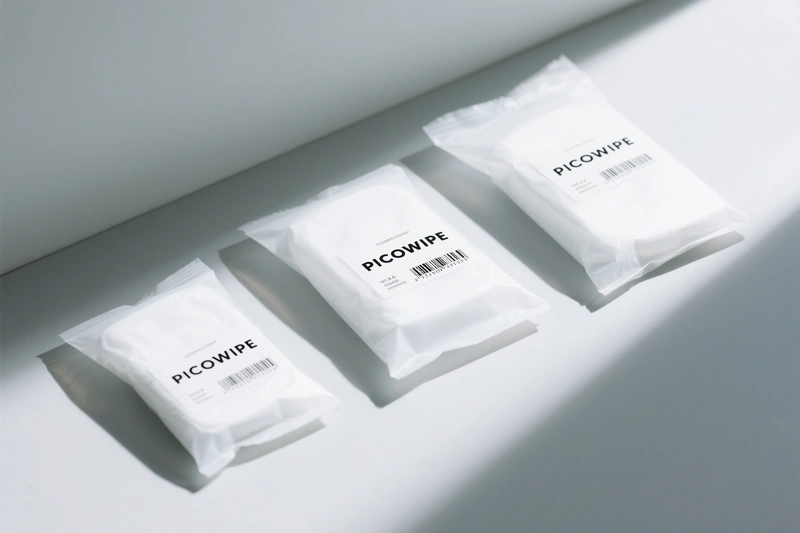By [email protected] — Charting the depths of expertise
I. Cleanroom Wipe Cleanliness Testing
Cleanroom wipes are primarily used in cleanroom environments. Key indicators for cleanliness testing include particulate residue, ionic contamination, and NVR (Non-Volatile Residue).
| Test Item | Test Standard | Method Summary |
|---|---|---|
| Particle Release | IEST-RP-CC004.4 | Using a Liquid Particle Counter (LPC) or Airborne Particle Counter (APC) to measure particles released after ultrasonic cleaning or agitation. |
| Ionic Contamination | IEST-RP-CC004.4 | Immersing the wipe in ultrapure water (18.2MΩ·cm) and using an Ion Chromatograph (IC) to detect ions like Na⁺, Cl⁻. |
| NVR (Non-Volatile Residue) | IEST-RP-CC004.4 | Extracting with a solvent (e.g., isopropyl alcohol), evaporating it, and weighing the residue. |
| Fiber Shedding | ISO 9073-10 or IEST-RP-CC004.4 | Determining fiber shedding after abrasion via microscopic observation or gravimetric method. |
| Absorption Rate | EDANA ERT 10.2 | Recording the time for the wipe to completely absorb 1mL of liquid (typically ≤5 seconds). |
Key Considerations:
Sampling Method: Operations must be conducted in a cleanroom (ISO Class 4~5) before testing to avoid environmental contamination. Solvent Choice: High-purity solvents (HPLC grade) must be used for NVR testing. Sample Handling: Wipes must be kept sealed before testing to prevent pre-contamination.
II. Antistatic Cleanroom Wipe TDS Report Testing
A TDS (Technical Data Sheet) is a document provided by the supplier, and its authenticity must be verified. Key areas for testing include antistatic properties, material composition, and cleanliness.
Core TDS Test Items:
| Test Item | Test Standard | Method Summary | Typical Requirement |
|---|---|---|---|
| Surface Resistance/Resistivity | ANSI/ESD STM11.11 | Measured using a surface resistance meter (e.g., Hiresta) with 10mm electrode spacing and 100V applied voltage. | 10⁶~10⁹Ω/sq (antistatic range) |
| Triboelectric Voltage | ANSI/ESD STM97.2 | Using an electrostatic voltmeter to measure the voltage after rubbing the wipe (typically required to be ≤100V). | ≤100V (low static generation) |
| Material Composition | FTIR or DSC analysis | Verifying if components like polyester and nylon match the TDS using Fourier Transform Infrared Spectroscopy (FTIR) or Differential Scanning Calorimetry (DSC). | Conforms to supplier's declaration |
| Cleanliness | Same as cleanliness tests above | Testing indicators such as particles, ions, and NVR. | Conforms to TDS declaration |
| Abrasion Resistance | ASTM D4966 | Testing performance changes after abrasion with a Martindale abrasion tester. | Resistance change ≤1 order of magnitude |
TDS Report Verification Points:
Data Consistency: Compare the deviation between measured data and the TDS statement (e.g., a resistance value within ±10% is acceptable). Test Conditions: Confirm that the test environment in the TDS (e.g., humidity 50%±5%) is consistent with the laboratory's. Certification Marks: Check for ESD certifications (e.g., ESDA certification) and cleanroom class ratings (ISO Class X).
III. Testing Instruments
| Test Item | Recommended Instrument | Brand Examples |
|---|---|---|
| Particle Counting | Liquid Particle Counter (LPC) | Particle Measuring Systems |
| Ionic Contamination | Ion Chromatograph (IC) | Thermo Scientific Dionex |
| Surface Resistance | High Resistance Meter / Surface Resistance Meter | Keysight, Hiresta |
| Electrostatic Voltage | Electrostatic Voltmeter | Trek, Simco |
| Material Analysis | Fourier Transform Infrared Spectrometer (FTIR) | PerkinElmer, Bruker |
IV. Precautions
Antistatic Properties: Must be conditioned for 24 hours in a controlled humidity environment (50%±5% RH) before testing. Cleanliness: After opening, wipes must be handled in a clean bench to avoid human contamination. TDS Authenticity: Request a third-party test report (e.g., INTERTEK) from the supplier.
V. Frequently Asked Questions
Q: What should be done if a cleanroom wipe fails the cleanliness test?A: Increase the number of ultrasonic cleaning cycles or switch to a low-residue solvent (e.g., electronic-grade isopropyl alcohol).
Q: What if the resistance of an antistatic cleanroom wipe exceeds the limit?A: Check the environmental humidity (low humidity increases resistance), or verify if an ineffective antistatic agent was used.


